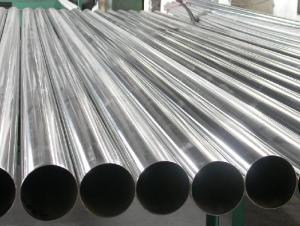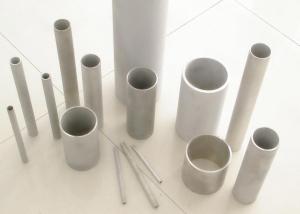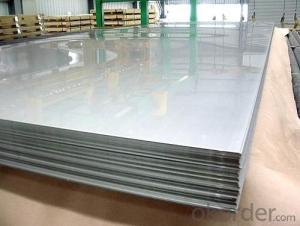Stainless steel sheet ASME 420 430 426 grade
- Loading Port:
- Shanghai
- Payment Terms:
- TT OR LC
- Min Order Qty:
- 3 m.t.
- Supply Capability:
- 25000 m.t./month
OKorder Service Pledge
OKorder Financial Service
You Might Also Like
Specification
Product Description
AISI 304( 18Cr-8Ni ) stainless steel is one of Austenitic stainless steel.
As a versatile steel, it has good corrosion resistance, heat resistance, low temperature strength
and mechanical properties. Meanwhile, it is quite good in pressing, bending and other thermal
processing.
Standard: ASTM A240 / A240M
Grade: 304 / 304L / 316 / 316L / 321 / 310S / 309S / 409 / 426 / 420 / 430 / 201...
Size: 1000*2000mm, 1220*2440mm, 1250*2500mm, 1500*3000/6000mm, 2000*6000mm
Special size can customized
Thickness: 0.3-20mm
Brand: TISCO, ZPSS, JISCO, BAO STEEL, LISCO
Surface: 2B, 2BA, BA, 1D, NO.1, NO.4, HL, Mirror, 8K
Chemical Composition
C | Cr | Ni | Mn | P | S | Mo | Si | |
304 | ≤0.07 | 17.00-19.00 | 8.00-10.00 | ≤2.00 | ≤0.035 | ≤0.030 | - | ≤1.00 |
304L | ≤0.030 | 18.00-20.00 | 8.00-10.00 | ≤2.00 | ≤0.035 | ≤0.030 | - | ≤1.00 |
316L | ≤0.030 | 16.00-18.00 | 12.00-15.00 | ≤2.00 | ≤0.035 | ≤0.030 | 2.00-3.00 | ≤1.00 |
317 | ≤0.12 | 18.00-20.00 | 11.00-15.00 | ≤2.00 | ≤0.035 | ≤0.030 | 3.00-4.00 | ≤1.00 |
317L | ≤0.08 | 18.00-20.00 | 11.00-15.00 | ≤2.00 | ≤0.035 | ≤0.030 | 3.00-4.00 | ≤1.00 |
309S | ≤0.08 | 22.00-24.00 | 12.00-15.00 | ≤2.00 | ≤0.035 | ≤0.030 | - | ≤1.00 |
310S | ≤0.08 | 24.00-26.00 | 19.00-22.00 | ≤2.00 | ≤0.035 | ≤0.030 | - | ≤1.00 |
Packaging & Shipping
Packaging way of stainless steel: Original packaging according to your needs. Standard export sea-worthy wooden packing.

Our Services
1.All product are made of high-quality stainless steel sheet;
2.We have good service & short delivery time;
3.We have professional export team;
4.We can provide sample for your evaluation;
5.We can provide Mill test certificate;
6.Your enquiry will get quickly and efficient response.
- Q: What is the maximum temperature that stainless steel sheets can withstand?
- The maximum temperature that stainless steel sheets can withstand depends on the grade of stainless steel being used. Generally, stainless steel is known for its high heat resistance and can withstand temperatures ranging from 1200°F to 1600°F (650°C to 870°C). However, the specific temperature threshold may vary depending on the grade of stainless steel, the thickness of the sheet, and the duration of exposure to high temperatures. It is essential to consult the manufacturer's specifications or a materials engineer to determine the maximum temperature tolerance for a specific stainless steel sheet.
- Q: Are stainless steel sheets suitable for outdoor signage?
- Stainless steel sheets are indeed appropriate for outdoor signage. This material is widely favored for outdoor uses because of its robustness, ability to resist corrosion, and pleasing appearance. It possesses exceptional resistance to rust and can endure harsh weather conditions, making it particularly suitable for outdoor signage that will be exposed to rain, sunlight, and extreme temperatures. Moreover, stainless steel sheets can be easily personalized and fabricated to craft diverse designs and forms, rendering them a versatile choice for outdoor signage. Furthermore, its sleek and polished finish adds a professional and contemporary touch to any signage. In summary, stainless steel sheets are a dependable and enduring alternative for outdoor signage.
- Q: Can stainless steel sheets be used for electrical applications?
- Yes, stainless steel sheets can be used for electrical applications. Stainless steel is an alloy that contains chromium, which makes it highly resistant to corrosion and oxidation. This corrosion resistance is beneficial for electrical applications where the material may be exposed to moisture or harsh environments. Stainless steel sheets can be used in various electrical components such as electrical enclosures, control panels, junction boxes, and electrical connectors. The high strength and durability of stainless steel make it suitable for these applications, providing a reliable and long-lasting solution. Additionally, stainless steel's non-magnetic properties can be advantageous in certain electrical applications where magnetic interference needs to be minimized.
- Q: Are stainless steel sheets suitable for cryogenic storage tanks?
- Yes, stainless steel sheets are suitable for cryogenic storage tanks. Stainless steel is known for its excellent corrosion resistance, which makes it highly suitable for storing low-temperature substances such as liquefied natural gas (LNG), liquid nitrogen, or liquid oxygen. Cryogenic storage tanks require materials that can withstand extreme low temperatures without becoming brittle or losing their strength, and stainless steel meets these requirements. Additionally, stainless steel has good thermal conductivity, which helps in maintaining the desired temperature inside the tank. It is also easy to clean and maintain, making it a preferred choice for cryogenic storage tanks in various industries.
- Q: What are the different types of stainless steel alloys used for sheets?
- Sheets can be made from various types of stainless steel alloys, each with its own unique properties and applications. Some commonly used stainless steel alloys for sheets include: 1. Austenitic Stainless Steel: This is the most commonly used type of stainless steel, offering excellent corrosion resistance, high ductility, and good formability. It finds applications in food processing, chemical equipment, and architecture. 2. Ferritic Stainless Steel: Ferritic stainless steel alloys are known for their high resistance to stress corrosion cracking and good thermal conductivity. They are commonly used in automotive exhaust systems, heat exchangers, and appliances. 3. Martensitic Stainless Steel: Martensitic stainless steel alloys are known for their high strength, hardness, and wear resistance. They find applications in cutlery, surgical instruments, and turbine blades. 4. Duplex Stainless Steel: Duplex stainless steel alloys combine the properties of both austenitic and ferritic stainless steels. They offer excellent corrosion resistance, high strength, and good weldability. They are commonly used in oil and gas industry equipment, chemical processing, and marine applications. 5. Precipitation-Hardening Stainless Steel: These alloys can be heat treated and provide high strength, good corrosion resistance, and excellent toughness. They are commonly used in aerospace components, the nuclear industry, and high-performance applications. Each stainless steel alloy has its own specific composition and properties, making it suitable for different applications. Factors such as corrosion resistance requirements, strength requirements, and the environment in which the sheets will be used determine the choice of alloy.
- Q: What glue does the board and the stainless steel stick to?
- In addition to the bonding (ordinary bonding and bonding structure), epoxy resin can be used for casting, sealing, sealing, sealing, anti-corrosion, insulation, conductive, fixed, reinforcement, repair etc., are widely used in aviation, aerospace, ships, railway, machinery, chemical industry, light industry, water conservancy, weapons, electronic and electrical, construction, medical, sports goods, arts and crafts, daily life and other fields.
- Q: Is the cold rolled steel plate good or the stainless steel plate?
- The cold rolled steel itself, whether washed by acid car wash, semi-finished products, or rolled out by cold rolling mill semi-finished products, their rust resistance is very poor. It is easy to oxidize, resulting in rust on the surface of the air. It will not rust until it has been plated with aluminum or zinc, and it is clear that the process is complex and unsafe.
- Q: Are stainless steel sheets suitable for outdoor sculptures or artwork?
- Outdoor sculptures or artwork can greatly benefit from the use of stainless steel sheets. This material is renowned for its exceptional durability and resistance to corrosion and weathering, making it the ideal choice for outdoor installations. Regardless of the harsh environmental conditions, such as rain, snow, UV rays, and temperature fluctuations, stainless steel retains its structural integrity and aesthetic appeal. Moreover, artists and designers can easily shape, cut, and weld stainless steel, allowing for the creation of intricate and complex sculptures. Its sleek and modern appearance also adds a contemporary touch to any outdoor setting. Additionally, stainless steel requires minimal maintenance and can maintain its original finish for an extended period, making it a cost-effective option for outdoor sculptures or artwork. In conclusion, stainless steel sheets are an excellent material choice for creating visually appealing and long-lasting outdoor artworks.
- Q: Are stainless steel sheets resistant to high-pressure environments?
- Yes, stainless steel sheets are highly resistant to high-pressure environments. Stainless steel is a strong and durable material that can withstand the pressure exerted by various industrial processes, such as hydraulic systems, chemical processing plants, and oil and gas pipelines. It is known for its excellent tensile strength and ability to maintain its structural integrity even under extreme pressure conditions. Additionally, stainless steel is also resistant to corrosion, which further enhances its suitability for high-pressure environments where exposure to moisture or chemicals is common. Overall, stainless steel sheets are widely used in industries that require materials capable of withstanding high-pressure conditions due to their exceptional strength and resistance properties.
- Q: What are the benefits of using perforated stainless steel sheets?
- There are several benefits of using perforated stainless steel sheets in various applications. Firstly, perforated stainless steel sheets offer excellent strength and durability. Stainless steel is known for its high tensile strength and resistance to corrosion, making it a reliable choice for applications that require strong and long-lasting materials. The perforations in the sheets also do not compromise their structural integrity, ensuring that they can withstand heavy loads and harsh environments. Secondly, perforated stainless steel sheets provide excellent ventilation and airflow. The perforations allow air and other gases to pass through the sheets, making them ideal for applications that require proper ventilation, such as HVAC systems, industrial machinery, and automotive components. This ventilation capability helps prevent the buildup of heat and moisture, which can be crucial in maintaining the efficiency and safety of various equipment. Additionally, perforated stainless steel sheets offer versatility in design and aesthetics. The ability to customize the size, shape, and pattern of the perforations allows for the creation of unique and visually appealing designs. This makes them suitable for architectural applications, interior design elements, and decorative purposes. The wide range of available perforation patterns also enables the control of light transmission, creating interesting lighting effects or privacy screens. Moreover, perforated stainless steel sheets have excellent filtration capabilities. The perforations can be designed to filter out specific particles or substances, making them ideal for applications in the food and beverage industry, pharmaceuticals, and water treatment systems. This feature ensures the cleanliness and purity of the materials or fluids passing through the sheets, improving overall product quality and safety. Lastly, perforated stainless steel sheets are easy to clean and maintain. Stainless steel is non-porous, making it resistant to stains, dirt, and bacteria. This property, combined with the perforations, allows for easy cleaning and disinfection, making them suitable for applications that require high levels of hygiene, such as commercial kitchens, medical facilities, and laboratories. In summary, the benefits of using perforated stainless steel sheets include their strength and durability, ventilation capabilities, versatility in design, filtration capabilities, and ease of cleaning and maintenance. These qualities make them a preferred choice in a wide range of industries and applications.
Send your message to us
Stainless steel sheet ASME 420 430 426 grade
- Loading Port:
- Shanghai
- Payment Terms:
- TT OR LC
- Min Order Qty:
- 3 m.t.
- Supply Capability:
- 25000 m.t./month
OKorder Service Pledge
OKorder Financial Service
Similar products
Hot products
Hot Searches
Related keywords


























